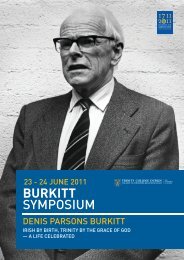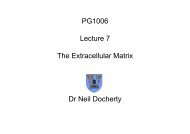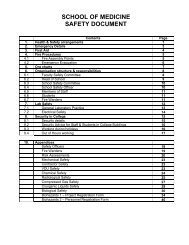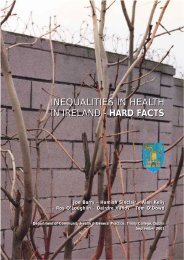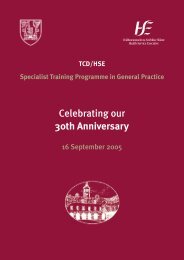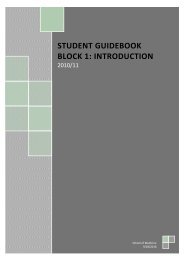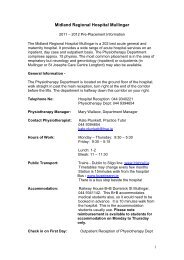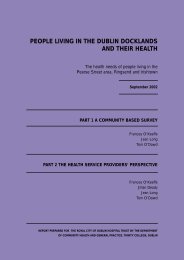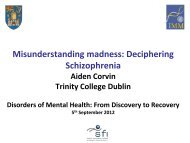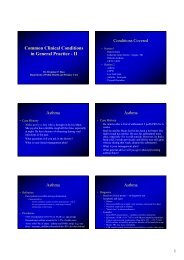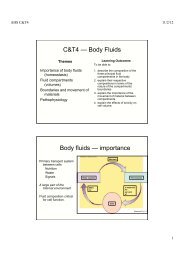Undergrad-Handbook-2.. - School of Medicine
Undergrad-Handbook-2.. - School of Medicine
Undergrad-Handbook-2.. - School of Medicine
You also want an ePaper? Increase the reach of your titles
YUMPU automatically turns print PDFs into web optimized ePapers that Google loves.
University <strong>of</strong> DublinTrinity College<strong>School</strong> <strong>of</strong> <strong>Medicine</strong>COURSE HANDBOOK PAEDIATRICS2010-20111
ContentsPage NumberWelcome and Introduction 3Studying Paediatrics at Trinity College 4Mission Statement 4Educational objectives 4Aims <strong>of</strong> the paediatric course 5Structure <strong>of</strong> the Course 6Content <strong>of</strong> the Course 6Lectures 9Paediatric Out-Patient List NCH 12Guidelines for Clinical Examination <strong>of</strong> Children and Dress Code 13Typical student day 15Examinations and Assessments 15Course Appraisal 18Recommended Reading List 19Library facilities 20How to Get to the Hospital 20Parking 20Appendix A Dress Code 22Appendix B Multiple Choice Examination with Sample Questions 23Appendix C Guidelines for Students at Examination 26Conduct <strong>of</strong> Examinations 282
Welcome and Introduction to the Department <strong>of</strong> PaediatricsThe Department <strong>of</strong> Paediatrics is based in the National Children’s Hospital in Tallaght and is part <strong>of</strong>the Adelaide and Meath Hospital Dublin incorporating The National Children’s Hospital (AMNCH).Paediatrics involves the medicine, surgery and psychology <strong>of</strong> the newborn, the infant, the toddler andthe child up to the age <strong>of</strong> 18 years.The National Children's Hospital has a long history <strong>of</strong> expertise in the training <strong>of</strong> clinicalpr<strong>of</strong>essionals. It is the oldest paediatric teaching hospital in Ireland and the UK and has a longassociation with Trinity College, dating back to 1821 and has held the chair <strong>of</strong> paediatrics since1960. A major objective <strong>of</strong> The Hospital since its foundation is the training <strong>of</strong> medical and nursingstudents and it has a recognised tradition <strong>of</strong> excellence in paediatric teaching.The aims <strong>of</strong> paediatric education are to provide knowledge, skills and attitudes, with a caring, child andfamily centred approach in an enjoyable and rewarding manner. Students are encouraged to develop alife-long commitment <strong>of</strong> self-learning and to become compassionate, caring, competent, and efficientdoctors, with well developed communicating skills. The Department <strong>of</strong> Paediatrics conducts, promotesand supports many national and international research programmes.The Paediatric undergraduate course comprises <strong>of</strong> an eight week comprehensive teaching programme,with lectures, presentations, roundtable discussions, evidence based projects and small group bedsideclinical teaching. The Department supports the philosophy <strong>of</strong> self-directed and life-long learning.Whilst students retain responsibility for their learning, this is supported by the extensive teachingprogramme and by the staff. Students are encouraged to supplement the programme provided withpersonal study and research. The course is provided in The National Children’s Hospital AMNCHTallaght and in addition students have a two week attachment at Our Lady's Children’s HospitalCrumlin and neonatal paediatric teaching is delivered at the Coombe Women's Hospital and at theRotunda Hospital. A number <strong>of</strong> visits to other healthcare institutions are also provided. All members <strong>of</strong>the medical staff are committed to ensuring that you have an enjoyable and instructive attachment. Wewelcome your opinions and value your appraisal <strong>of</strong> the course. If you have any queries or problemsplease let us know.Dr Edna Roche, Senior Lecturer, Head <strong>of</strong> Department <strong>of</strong> Paediatrics, 01 896 3763Dr Judith Meehan, Lecturer01 896 3771 jmeehan@tcd.ieDr Anne Marie Murphy, Lecturer 01896 3771 murpha43@tcd.ieMs Siobhan Tynan-O Mahony, Executive Officer and Secretary 01 896 3763Ms Sandra Kenny, Executive Officer and Part-Time Secretary 01 896 3747 s.kenny@tcd.ieDepartment <strong>of</strong> PaediatricsTrinity Centre for Health SciencesNational Children’s HospitalTallaght, Dublin 243
STUDYING PAEDIATRICS AT TRINITY COLLEGEThe attachment in Paediatrics comprises: a 6 week attachment at the National Children’s Hospital,AMNCH, Tallaght; visits to outside institutions; a 2 week attachment at Our Lady’s Children’sHospital, Crumlin; a neonatal attachment during the Obstetrics/Gynaecology programme; and aseries <strong>of</strong> neonatal lectures during the Obstetrics/Gynaecology lecture programme.An extensive programme <strong>of</strong> lectures, presentations and small group teaching is provided. Whileevery effort is made to ensure that scheduled events take place as planned or are rescheduled,sometimes this is not possible due to clinical commitments and clinical emergencies. The care andwell-being <strong>of</strong> the child must take precedence over all else.The Department <strong>of</strong> Paediatrics supports the philosophy <strong>of</strong> self-directed learning and life-longlearning. Students must retain responsibility for their learning which is supported by the extensiveteaching programme and teaching staff. The teaching programme is as comprehensive as ourallocated time permits. However, it is not possible or desirable to cover every aspect <strong>of</strong> the vast area<strong>of</strong> Paediatrics in lectures and tutorials and so students are required to supplement the programmeprovided with personal study and research.MISSION STATEMENTThe aims <strong>of</strong> paediatric education are to learn the knowledge, skills and attitudes, with a caring, child andfamily centred approach in an enjoyable and rewarding manner. The students are encouraged todevelop a life-long commitment <strong>of</strong> self-learning and to become compassionate, caring, competent, andefficient doctors, with well developed communicating skills. The course is delivered using a caringchild and family centred approach encompassing a multidisciplinary team committed to continualimprovement in clinical care through innovation and research.EDUCATIONAL OBJECTIVESPaediatrics involves the medicine, surgery and psychology <strong>of</strong> the newborn, the infant, the toddlerand the child up to the age <strong>of</strong> 18 years. Your goals during the attachment are to acquire thefollowing knowledge, skills and attitudes:4
Knowledge and Understanding <strong>of</strong>:1. Growth, development and nutrition, fluid requirements and family dynamics<strong>2.</strong> The assessment, diagnosis and management <strong>of</strong> acute and chronic illness.3. The prevention <strong>of</strong> illness by immunisation, by screening tests such as the Guthrie test atbirth, developmental assessment, hearing tests etc., and health promotion.Skills in:1. History taking, communication skills with children, parents and the whole family.<strong>2.</strong> Clinical examination skills to detect abnormalities and to diagnose illness.3. Management by initiating investigation and treatment.4. Problem solving and critical analytical skills.Attitudes:Students are encouraged to: be enthusiastic, committed and efficient; show concern, compassion andrespect towards the child, parents, hospital staff and colleagues; have a pride in belonging to thehospitals and university; be non-judgemental <strong>of</strong> parents, children, and adolescents <strong>of</strong> differing socialbackgrounds and values; and to critically evaluate journals, knowledge and new developments.AIMS OF THE PAEDIATRIC COURSEEducators Targets1. To teach the recognition <strong>of</strong> the well and the ill infant or child taking a thorough history andperforming clinical assessment. Clinical examination is taught on the wards and in the accidentand emergency department. Use <strong>of</strong> the Clinical Skills Laboratory and interactive modules isencouraged<strong>2.</strong> To emphasise the importance <strong>of</strong> growth and development in childhood3. To provide sound basic knowledge <strong>of</strong> childhood health and diseaseStudents Targets1. To be able to communicate adequately with children and their parents<strong>2.</strong> To be able to take a good paediatric history3. To be able to examine the 4 ages <strong>of</strong> childhood, newborn, infant, toddler and older child4. To be able to construct a reasonable differential diagnosis5. To be able to plan appropriate investigation and management5
STRUCTURE OF COURSEThe Department <strong>of</strong> Paediatrics is based at the National Children’s Hospital, Tallaght. Paediatrics istaught almost entirely on site, with a two week attachment to Our Lady’s Children’s Hospital Crumlinand neonatal paediatrics is taught in the Coombe Women and Infants University Hospital and in theRotunda Hospital.The programme is full time daily from 8.30 am – 5 pm for 2 months. In view <strong>of</strong> the numbers <strong>of</strong>students in each medical year the class is divided into four groups, each attending in a different 2 monthperiod.There is a formal revision course in paediatrics prior to the final examinations. This takes the form <strong>of</strong>revision lectures, instruction in exam technique and tutorials revising the principles <strong>of</strong> clinicalexamination <strong>of</strong> children. During this period the student again has access to the paediatric patients.CONTENT OF COURSEThe course in paediatrics provides both instruction in theory and clinical practice on the followingsubjects: neonatology, respiratory, cardiac, renal, gastrointestinal, endocrine, haematology, infections,neurology, rheumatology, diabetes, metabolic, chromosomal, malignancies, psychological, psychiatric,surgical, orthopaedic, and accident and emergency problems.The emphasis <strong>of</strong> the course is to enable students to avail <strong>of</strong> their time in a paediatric hospital to developtheir clinical skills. To this end, each student is involved in daily small group bedside teaching and willspend time with parents and patients. History taking, performing physical examination and regularattendance at Out-patients provides learning opportunities for the investigation, diagnosis andmanagement in the full spectrum <strong>of</strong> paediatric conditions seen. Students are expected to undertake someindependent reading from the textbooks recommended - a list <strong>of</strong> which can also be found herein.There is a comprehensive series <strong>of</strong> lectures given over the two months covering all major topics inpaediatrics. These are mainly given in the Lecture Theatre <strong>of</strong> the Trinity Health Sciences Building,Tallaght. You will find a list <strong>of</strong> topics covered in this handbook. There are also small group bedsideclinical tutorials on the medical and surgical wards, accident and emergency department, paediatric high6
dependency unit, operating theatre, outpatient department, paediatric growth and endocrinologylaboratory, cystic fibrosis assessment units, X-ray department and in the pathology, paediatricpulmonary function and cardiac laboratories. A detailed programme is given to each student on the firstday <strong>of</strong> the course. There are also case presentations, roundtable discussion groups, computer assistedlearning and audio-visual equipment.To complement small group bedside teaching and also promote self directed learning a Clinical SkillsLaboratory has been developed in the Department which enables students to practice and refine theirexamination techniques in a less stressful environment.Students are rostered in small groups <strong>of</strong> 2-3 for a day and an evening in the department under thesupervision <strong>of</strong> the medical and nursing staff, following a particular patient. They are expected to take ahistory, perform an examination and become involved in the management <strong>of</strong> the patient. Follow up <strong>of</strong>patient progress is recommended. Each student presents their case to the class and lecturer in aninteractive session. The presentation is in the form <strong>of</strong> a 5min power point presentation to the wholeclass. This encourages learning and participation in the A and E department. It provides anopportunity for students to learning about the presentation, investigations and the acute management <strong>of</strong>common paediatric medical and surgical problems in a proactive way.In addition there is also an evening and a weekend roster allocating each student an evening and aweekend in the hospital attending the wards and the Accident and Emergency department. This willallow the student to shadow the registrar and senior house <strong>of</strong>ficer on duty and see a range <strong>of</strong> clinicalcases. Students should also attend the post call ward round at the weekend when rostered.A group project is performed with emphasis on clinical skills. A further aim <strong>of</strong> this group project is toimprove student’s collaborative skills.A number <strong>of</strong> special visits are arranged for students in other institutions where they are given anopportunity to experience the facilities available for children with special needs, such as physicaldisabilities or severe learning difficulties. The participating institutions include The Sunshine Homewhere education relating to the value <strong>of</strong> the multidisciplinary care is provided.7
Core CurriculumDetails <strong>of</strong> the obligatory knowledge and skills which you must acquire are set out below:Clinical Skills1. How to elicit an accurate and relevant history <strong>of</strong> the patient’s problems<strong>2.</strong> How to approach, communicate with, play with, wash, feed, nappy change, give medicines to,and examine infants and children3. Examination <strong>of</strong> cardiovascular system in a child (including blood pressure)4. Examination <strong>of</strong> respiratory system in a child (including ENT)5. Examination <strong>of</strong> abdomen in a child. Examination <strong>of</strong> the genitalia should only be performed inappropriate circumstances and then only in the presence <strong>of</strong> a staff chaperone. The performance<strong>of</strong> rectal examination by medical students is neither recommended nor appropriate.6. Examination <strong>of</strong> nervous system in a child (including fundi)7. Demonstration <strong>of</strong> simple developmental milestones8. Assessment <strong>of</strong> growth and puberty9. Explaining common conditions and management to parents e.g. febrile convulsions, meningitis,asthma, croup, urinary tract infection10. Counselling parents e.g. vaccination advice, nappy rash, breast feeding problems11. Recognising an ill child1<strong>2.</strong> Examination <strong>of</strong> the newborn13. Examination <strong>of</strong> skinKnowledge1. Principle paediatric medical, surgical and psychiatric problems: mode <strong>of</strong> presentation,symptoms, signs, diagnosis, etiological mechanisms and related investigations<strong>2.</strong> Principles <strong>of</strong> patient management in paediatrics3. Common paediatric medical, surgical and psychosocial emergencies & their management4. Normal development5. Normal growth and puberty6. Infant feeding and nutrition in childhood7. Immunisation8. Child health surveillance including normal development9. Family health and disability issues e.g. effect on education, SIDS, child abuse8
LECTURESDr Edna RocheDr Basil ElnazirDr D WebbDr Judith MeehanDr Anne-Marie MurphyDr Hadar AhmedDr Paul McNallyDr Joanne BalfeDr Denise McDonaldDr Corrina McMahonDr Beatrice NolanDr David ColemanPr<strong>of</strong>essor R FitzgeraldMr John GillickSubject <strong>of</strong> LectureDiabetesPuberty and Disorders <strong>of</strong> the Adrenal and SexDevelopmentThyroid DiseaseRespiratory InfectionsAsthmaThe Floppy InfantEpilepsies <strong>of</strong> ChildhoodTaking a Paediatric History/Introduction to ClinicalExamination <strong>of</strong> ChildrenDevelopmental AssessmentEvidence Based PaediatricsClinical Problems X 3Growth and use <strong>of</strong> Centile ChartsInfectious Diseases/ImmunisationsAccidents/PoisonsClinical Problems X 3Fluid Management/CaloriesPubertyCystic FibrosisChild AbuseLearning disabilitiesAnaemiaSickle Cell DiseaseCoagulationCongenital Heart Disease/CVS ExaminationIntroduction to Paediatric SurgeryVomiting in InfancyRecurrent Abdominal Pain in ChildhoodCommon Problems in Paediatric SurgeryBedside Clinical Interactive Paediatric SurgeryWorkshops9
Dr Ciara MartinRecognition and Management <strong>of</strong> Acute Illness inChildrenPaediatric Emergencies and TraumaMr L DassThe Urinary Tract and Genito-urinary SurgeryPr<strong>of</strong>essor Eileen Treacy Inherited Metabolic Disorders - Part 1Inherited Metabolic Disorders - Part 11Dr Brendan DoodyAdolescent PsychiatryChildren in HospitalDr Hugh MonaghanCerebral PalsySpina BifidaMs Sinead FeehanInfant feeding and special dietary requirements inPaediatricsDr Rabab AhmedBacterial MeningitisDr MeenalMavinkurveNephritisDr Martin RyanX-rays in ChildhoodDr Louise GallagherAutism and ADHDDr. Maureen ConnollyPaediatric DermatologyDr Aengus O MarcaighLeukaemiaBedside Clinical Interactive Paediatric WorkshopsDr NadeemUrinary Tract InfectionDr Joan MurphyManagement <strong>of</strong> Down Syndrome and DisabilityNr Elaine O’MullaneGrowth in Infancy and ChildhoodMr E FogartyPaediatric OrthopaedicsMr David OrrPaediatric Plastic Surgery IPaediatric Plastic Surgery IIPr<strong>of</strong>essor Andrew GreeneClinical GeneticsDr Anne O’MearaOverview <strong>of</strong> Childhood CancersDr Jane PearsOncology TeachingDr Annemarie BroderickPaediatric GastroenterologyPr<strong>of</strong>essor Billy BourkeFailure to Thrive and DiarrhoeaDr Imelda RyanChild Sexual AbuseDr Michael CapraUnderstand the Basics <strong>of</strong> CancerDr Ronan O’SullivanBedside Clinical Paediatric A&E WorkshopsDr Sean WalshBedside Clinical Paediatric A&E Workshops10
Dr. Margaret Sheridan-PereiraDr. D CorcoranThe Ill NewbornNewborn Neonatal ExaminationThe Preterm InfantIntra-Uterine Growth Retardation (IUGR)Respiratory Conditions in the Term InfantNeonatal Asphyxia, Encephalopathy and SeizuresCongenital Malformation, Metabolic ScreeningNeurodevelopment, Neonatal OutcomeNeurodevelopment DisabilitiesBreastfeeding and Nutrition, Feeding ProblemsHIE (Hypoxic Ischaemic Encephalopathy)NAS (Neonatal Abstinence Syndrome)JaundiceOrthopaedic Problems <strong>of</strong> the NewbornDermatology and Skin Changes in the NewbornPreterm InfantNeonatal Neurology & Perinatal AsphyxiaCongenital Malformations (Surgical)Congenital Malformations (Genetic)Noscomial Infections & SepsisJaundice, Anaemia and HaematologyCourse Overview, Newborn History and PhysicalNeonatal TransitionFeeding and NutritionCommon Problems11
PAEDIATRIC OUTPATIENT CLINIC LIST (NCH Tallaght)DAY TIME ROOM NO CLINIC CONSULTANTMONDAY AM 9.00-13.00 110 - 120 Endocrine Dr H Ahmed09.00 – 13.00 107 - 109 Endocrine Dr Roche09:15 - 12:00 ENT Rooms A&E ENT Mr McShane10:00 - 13:00 Dental Rooms Dental Dr O'Connell09:30 - 12:00 10 J Sweat Test Bio-ChemistryMONDAY PM 14:00 - 17:00 107 Medical Asthma Nurse14:00 - 17:00 108 - 110 Medical/Respiratory Dr Greally14:00 - 16:00 119 - 120 / Tx Room Development Dr Curtis13:00 - 16:00 115 - 118 Orthopaedic Mr KielyTUESDAY AM09:00 - 11:00 Diabetes Tx Room Weight Management Nurse Led08:30 - 10:00 115 - 118 Surgical Mr B Sweeney09:30 - 12:00 10 J Sweat Test Bio-Chemistry10:00 - 13:00 107 - 109 Medical Dr Quinn09:15 - 12:00 ENT Rooms ENT Mr McShane10:00 - 12:00 117 - 119 Medical Dr Manning09:00 - 12:00 120 Asthma Asthma Nurse2 nd Tues / month 11:00 - 13:00 115 - 117 Weight Management Dr RocheTUESDAY PM 13:30 - 16:00 119 - 120 Development Dr McDonald14:00 - 16:00 107 - 110All except 1 st Tues 14:00 - 16:00 115 - 118 Cardiology Dr ColemanLast Tues / month 12:00 - 13:00 Adolescent Gynaecology Pr<strong>of</strong>essor P. Crowley1 st Tues / month 14:00 - 17:00 115 - 118 Cardiology Dr ColemanWEDNESDAY AM 09:00 – 01:00 115 - 120 Diabetic Dr Ahmed/Dr Roche09:00 - 12:00 107 Asthma Asthma Nurse09:00 - 12:00 108 Medical/Respiratory Dr El-Nazir - Registrar09:00 - 12:00 109 - 110 Medical/Respiratory Dr CoghlanWEDNESDAY PM 12:00 - 15:00 115 - 118 Orthopaedic Mr Moore14:00 - 16:00 107 - 110 Medical/Respiratory Dr El-NazirAlt. Wednesday 14:00 - 16:00 119 - 120 Gastroenterology/Community Dr Broderick/Dr Balfe14:00 - 16:00 122 Wart Clinic Dermatology Nurse3 rd Wed / month 14:00 - 16:00 10 J Smoking CessationTHURSDAY AM1 st & 3 rd Thurs 08:00 Ophthalmology Ophthalmology Pr<strong>of</strong>. Cassidy09:00 - 10:00 110 Treatment Room Surgical Mr Sami Awadalla2 nd & 4 th Thurs 09:00 - 12:00 ENT Rooms ENT Mr Conlon09:30 - 12:00 115 - 117 Rapid Access Dr Coghlan09:30 - 12:00 119 - 120 Neurology Dr Webb09:30 - 12:00 10 J Sweat Test Bio-Chemistry+/- Allergy Clinic Asthma NurseTHURSDAY PM 12:00 - 14:00 115 - 11814:00 - 17:00 118 - 120 Medical Dr Quinn13:30 - 17:00 107 - 110 Dermatology Dr Connolly14:00 - 17:00 X-Ray Scans X-Ray1 st Thurs / month 13:30 ENT Rooms ENT Mr KinsellaFRIDAY AM 08:30 - 13:00 107 - 110 / Tx Room Cystic Fibrosis Dr Greally / Dr El-NazirX-Ray MCUG MCUG10:00 - 12:00 115 - 110 Development Dr McDonald10:00 - 12:00 117 - 120 Medical Dr CurtisFRIDAY PM 13:00 - 17:00 115 – 118 Orthopaedic Mr Noelle12
GUIDELINES FOR THE CLINICAL EXAMINATION OF CHILDRENThe care and safety <strong>of</strong> children in hospital is the key concern <strong>of</strong> those working with children. Youwill no doubt be aware, through media reports, <strong>of</strong> concerns regarding the safety <strong>of</strong> children inhospital. The exposure to allegations <strong>of</strong> sexual abuse or misconduct in the care <strong>of</strong> children must beconsidered at all times by those who are involved in the history taking from relatives/children andthe clinical examination <strong>of</strong> children. It is with this in mind and for your protection that the followingguidelines must be adhered to during your time in Paediatrics.Identification badges with both name and photograph must be worn at all times by students while inthe hospital or attending special visits to other institutions. These badges must be prominentlydisplayed at the neck or lapel area. It is vital that you introduce yourself clearly to the parent andchild.Permission must be sought from the Ward Sister <strong>of</strong> Senior Staff Nurse on duty prior to theexamination <strong>of</strong> any child on the wards. Parental permission and the permission <strong>of</strong> the childthemselves should also be sought, where the child is old enough. Be mindful <strong>of</strong> meal times andvisiting hours.Familiarise yourself with and observe any isolation procedures. Please wear a plastic apron whileexamining patients on infant wards. Please wash your hands before and after examining any patient.Stethoscopes or toys used while examining children should be wiped down with Alco wipes beforeseeing patient.The well being <strong>of</strong> the child is the responsibility <strong>of</strong> the examining medical student during theexamination and must take precedence over any personal learning objective. The child must be leftin safety and comfort at the end <strong>of</strong> any examination. i.e. with cot sides up and changed as necessary.NEVER leave a cot side UNATTENDED, and make sure the cot side is up and secure when leavingthe cubicle.The privacy and dignity <strong>of</strong> children should be respected at all times. It is not acceptable that a childbe distressed, hurt or embarrassed during a clinical examination. Unnecessary exposure <strong>of</strong> a child isnot justified, especially in a pubertal child, as this causes distress and embarrassment.13
Certain procedures are not indicated at this level <strong>of</strong> examination and include any intimateexaminations, such as palpation <strong>of</strong> the breast or examination <strong>of</strong> the genitalia in a pubertal child.Examination <strong>of</strong> the genitalia in a pubertal child, if indicated, should only be performed in thepresence <strong>of</strong> a staff member with a parent present where possible.It is recommended for your own protection and from a learning point <strong>of</strong> view that clinicalexamination <strong>of</strong> children be performed in groups <strong>of</strong> two students. In the absence <strong>of</strong> a second studentanother party can be recruited to act as a chaperone, perhaps a nurse or doctor would oblige.It is recommended that after taking a history or examining a child on the wards that you sign yourname and student ID number in the patient’s chart. Confidentially is <strong>of</strong> paramount importance andcare should be taken not to discuss patients on public corridors or within hearing <strong>of</strong> non staymembers.Barrier Nursing:Open cubicle with elbowWash hands and dry on paper towelPut paper towel in foot-operated bucketPut on plastic apron and examine patientRemove plastic apron and wash as beforeLeave cubicle by opening door with elbowWe emphasised that these guidelines exist for both the patients and your protection.DRESS CODEDress Code is an important aspect to pr<strong>of</strong>essional practice and is part <strong>of</strong> your training in becomingdoctors. It also forms part <strong>of</strong> your responsibilities as described by the Irish Medical council.Pr<strong>of</strong>essional: patients should be confident that the student is part <strong>of</strong> the pr<strong>of</strong>essional team involvedin their care.Respectful: patients should never feel that their personal, ethnic or religious convictions arecompromised because <strong>of</strong> inappropriate dress.Safety: dress must conform to the local health and safety regulation. This is to protect both thestudent and the patient.See Appendix A for Detailed Guidelines14
TYPICAL STUDENT DAY8.30 Student presentations <strong>of</strong> paediatric ED cases9.00 Lecture10.00 C<strong>of</strong>fee10.30 Bedside clinical teaching1<strong>2.</strong>00 Lecture1.00 Lunch<strong>2.</strong>00 Lecture3.00 - 5.00 Examination <strong>of</strong> children on Wards/Attendance inEmergency Department, laboratories, operating theatre,Clinical Skills Laboratory.EXAMINATIONS AND ASSESSMENTSThere is a continuous assessment during the course and a final examination is held at the end <strong>of</strong> theacademic year in June when student performs a written and a clinical examination. Details areprovided below1. Continuous AssessmentThere is continuous assessment throughout the course, with feedback to students in order to direct andmotivate their studies. Students must acquire name badges and display them prominently.30% <strong>of</strong> the total marks for the course are given during the attachment. The allocation <strong>of</strong> marks is asfollows:Month 18% Objective structured Clinical Examination4% Clinical Case Reports (one medical and one surgical case)OSCEAn OSCE examination is held at the end <strong>of</strong> the fourth week <strong>of</strong> the course designed to assesscommunication and clinical skills.15
Clinical Case Reports: Each student must submit 2 written case reports (one medical, one surgical)in the format <strong>of</strong> a word document as per the history format and examination format in the lecturegiven. This involves each student taking a paediatric history in full from a parent and child,performing a physical examination on the child, discussing differential diagnosis and management atthe end. The purpose <strong>of</strong> this is to ensure every student is familiar with the format <strong>of</strong> paediatrichistory taking and examination. A centile chart should also be submitted with a recent height andweight <strong>of</strong> the child. The report should be submitted to Ms Siobhan Tynan-0 Mahony and signed inas per the date on your program.Month 210% Objective structured Clinical Examination (OSCE)4% Group Project4% Neonatal examination (to be held during Obstetrics & Gynaecology attachment)OSCEIn the second month students must perform a second OSCE designed to assess communication, clinicalskills and data interpretation.Group ProjectStudents are also required to submit a group project which focuses on clinical examination techniquesincluding aspects <strong>of</strong> evidence based paediatrics. Project topics will be allocated to each group early inthe attachment and a plan <strong>of</strong> work devised. Members <strong>of</strong> the teaching staff provide help and guidancewhile students are preparing for this work.Neonatal ExamA neonatal clinical examination is held during the neonatal programme.Feedback after AssessmentsFeedback will be provided after the assessments in the lecture theatre. A feedback session will takeplace in the lecture theatre and will include examiners observations on clinical skills andinterpretation and approach to patient. It is important that this session is attended by all the students.Students who have performed poorly and have not achieved the pass mark will be met individuallyby the lecturers to discuss their results.16
<strong>2.</strong> Final Examination in PaediatricsThe final examination in Paediatrics takes place in June for all groups and 70% <strong>of</strong> the total marks areallocated to this exam. The student performs a written and a clinical examination including onemajor/long case and one or more short cases.Written Examination in PaediatricsThe written exam takes place before the clinical exam. It comprises <strong>of</strong> a multiple choice question paperand 20% <strong>of</strong> the total marks for the course are allocated to this written examination. See Appendix B forsample questions, guidelines for students at examinations and conduct at examinations.The marking system will be as follows:Negative Marking Will ApplyCorrect answer +1 mark, Incorrect answer –0.5 markClinical Examination in Paediatrics50% <strong>of</strong> the total marks are allocated to this clinical examination and are divided equally between themajor and minor case(s). Students must pass this clinical component <strong>of</strong> the examination and obtainan overall pass mark. Students who fail the clinical segment <strong>of</strong> the examination will be required torepeat the whole examination. Students may be recalled for an Honours Viva Voce or for a borderlinePass Viva Voce at the examiners discretion.Please note that candidates who have passed with honours or candidates who have failed outright MAYNOT be called for a viva. You will be notified by one <strong>of</strong> the supervisors after the clinical examinationas to whether or not you will be required for a viva.Hospital allocations will be posted on notice boards in the Faculty <strong>of</strong> Health Sciences, Trinity College,the Trinity Centre at St. James’s Hospital and the Trinity Centre at Tallaght Hospital on the Fridaypreceding the clinical examinations. The actual Hospital and time <strong>of</strong> your clinical examination will beposted on the above notice boards by 1<strong>2.</strong>30 p.m. on the day prior to your Clinical. It is not possible togive this information by telephone.The overall Final results will be published in the Medical <strong>School</strong>, Trinity College after the Examiners’meeting.17
AwardsPr<strong>of</strong>essors Prize in PaediatricsA medal is awarded to the student with the highest mark in the final medical examination in paediatrics.Board <strong>of</strong> Governors PrizeA separate voluntary examination takes place for those students who wish to participate in thisexamination. This is an open competition for the Board <strong>of</strong> Governors Prize and takes the form <strong>of</strong>written paper and slide interpretation.Prize for Best Group ProjectOne group project from each attachment will be selected on merit and the four best group projects <strong>of</strong>the year will be presented in both oral and poster format to the whole class in June. There will be aprize for the best group project.Dates for Final Exams and Prize Exams – 2010MCQ Paper – Trinity College during the second week in June 2011Clinical Examinations during the Third week in June 2011Presentation <strong>of</strong> 4 best student projects in the year Date to be announcedBoard <strong>of</strong> Governors Prize Exam Date to be announcedA revision course will commence prior to the Final ExamsSupplemental ExaminationsFor those students failing to pass their final Paediatric exams in June <strong>of</strong> their final year, repeatexaminations take place in August. Revision tutorials for repeat students are provided in the weeksleading up to the exam. Please contact the Lecturers relating to this.COURSE APPRAISALThe Department <strong>of</strong> Paediatrics <strong>of</strong> the University <strong>of</strong> Dublin is committed to excellence in its Paediatrictraining. It is proactive and constantly seeks to improve the quality <strong>of</strong> its programmes by exploring newtechnologies and teaching methods. Student feedback is encouraged by the provision <strong>of</strong> detailed courseappraisal questionnaires to each student on completion <strong>of</strong> their Paediatric attachment. The resultingappraisals are analysed and a report compiled and discussed within the Department. Continual coursereview is practised within the Department.18
RECOMMENDED READING LISTBasic TitlesTitleAuthor1. Essential Paediatrics Hull and Johnston(The most current basic text)<strong>2.</strong> Illustrated Textbook <strong>of</strong> Paediatrics Lissauer & Clayden3. Lecture Notes on Paediatrics Smithells & Meadow(alternative basic text, less comprehensive)4. Paediatric Physical Examination Gill & O'Brien(A handbook for the clinical attachment)Recommended Texts5. Colour Atlas <strong>of</strong> Paediatric Dermatology Verbov(Essential to see the full range <strong>of</strong> skin conditions no longer seen as in-patients)6. The Normal Child Illingworth(A textbook <strong>of</strong> developmental paediatrics)7. From Birth to Five Years Mary D. Sheridan(Children’s developmental progress)Reference Texts1. Textbook <strong>of</strong> Paediatrics Forfar & Arneil<strong>2.</strong> Nelsons Textbook <strong>of</strong> Paediatrics Vaughan & McKay3. Recognisable patterns <strong>of</strong> Human Malformation Smith4. Essentials <strong>of</strong> Paediatric Surgery Nixon & O'Donnell5. Paediatric problems in General Practice Robert Boyd & Michael Modell6. Clinical Paediatrics for Postgraduate examinations Stephenson & WallaceLIBRARY FACILITIESStudents may avail <strong>of</strong> the facilities <strong>of</strong> the Tallaght Hospital library which houses an extensive range <strong>of</strong>paediatric textbooks and journals.Access is also available to Medline and the Internet for computerized data searches. Students may alsouse the libraries in St. James’s University Hospital, Trinity College and Our Lady’s Children’s Hospital,Crumlin.19
HOW TO GET TO THE NATIONAL CHILDREN’S HOSPITAL TALLAGHTThe Hospital is situated in South-West Dublin in Tallaght. It is close to the M50 Motorway and the N81Road. The Hospital is located less than 1Km <strong>of</strong>f the N81 City Centre to Blessington Road (TallaghtBypass) on Belgard Square.Via Dublin Bus from City Centre - 49, 50, 77 & 77A from Eden QuayThe LUAS light rail link passes the hospital and there is a LUAS stop near the Trinity CollegeHealth Sciences Building (to the West <strong>of</strong> the Hospital).PARKINGAll visitors wishing to park within the Hospital grounds must park in the multi story car park in thehospital. The car park is privately run and incurs a charge per hour.The car park is situated on the right hand side <strong>of</strong>f the second roundabout as you progress into thehospital grounds by car and is clearly signposted.20
Appendix A DRESS CODEThe following table is provided as a guide to appropriate dress. There will be local differencesbetween clinical units and local guidelines should be observed. The student should exercisereasonable discretion in choosing appropriate dress. Clothing should not restrict easy movement froclinical procedures.AppropriateGrooming • Hair: Neat and clean hair,should be secured back fromthe face if shoulder length orlonger.• Finger nails should be shortand clean.AttireMen• Smart trousers, clean andpressed• Collared shirt with tieWomen• Blouse or smart topInappropriate• Hair covering face• Jeans/denim• T-shirts• Plunging neckline• Midriff exposure• Strapless/string strappedblouse21
• Smart-casual trouser or skirt• Smart dressesFootwear • Formal shoes, well kept andclean and work withsocks/hosiery as appropriate.• Safe footwear (closed) isrequired in many clinical sites.Jewellery • No more than 2 earrings perearWhite coatsIDIf a white coat is used it must complywith infection control standards.Prominently displayed hospital orstudent ID depending on theenvironment.• Crop tops• Track suits• Camouflage clothing• Hooded sweatshirts• Prominent slogans or imagesthat may cause <strong>of</strong>fence• Clothing tears, holes and rips• Trainers• Running shoes• No other visible bodypiercing is permitted(nose/tongue etc)• Excessive jewellery is notpermittedWhite coats are no longer necessaryfor medical students in clinical are.No identificationThese rules apply to the clinical areas. However if you are involved in any teaching involving apatient you should ensure that your dress will not cause <strong>of</strong>fence to the patient, the staff or visitors.22
Appendix BMultiple Choice Examination in Paediatrics Sample QuestionsXID:XPAMHA1UNIVERSITY OF DUBLINTRINITY COLLEGESCHOOL OF MEDICINEFINAL PAEDIATRIC EXAMINATION – 2009MULTIPLE CHOICE QUESTION EXAMINATIONJune 2009 VENUE 9.30 a.m. – 11 a.m.PROFESSOR HILARY M.C.V. HOEYAll examination papers to be returned to the invigilator at end <strong>of</strong> examinationDO NOT REMOVE FROM EXAMINATION VENUEINSTRUCTIONS TO CANDIDATESPlease note you must answer the MCQ questions using a PENCIL and you must fill in yourStudent Number and your name on the answer sheet provided. Answer each question bychoosing either T for True or F for False. Negative marking at 0.5 for each question willapply.23
Sample MCQ QuestionsThe following observations would give serious grounds for concern in a 1 year old baby:1. Failure to pass a cube from hand to hand<strong>2.</strong> Inability to stand without support3. Inability to sit for 3 seconds4. No meaningful words other than “mama” and “dada”5. Adapts easily to admission to hospital without motherHuman breast milk:6. Is rich in secretory IgA7. Is contraindicated in galactosaemia8. Is contraindicated in hereditary fructose intolerance9. Is produced in response to prolactin10. Is low in phosphorus compared with Cow’s milkShort stature is associated with:11. Chronic renal disease1<strong>2.</strong> Malabsorption13. Down’s syndrome14. Emotional deprivation15. Low birth weightSimple febrile convulsions:16. Is more common in girls17. Usually lasts less than 15 minutes18. Occurring more than twice in a year is an indication <strong>of</strong> prophylactic anticonvulsant19. Is usually focal20. Is associated with characteristic EEG changes24
Before filling in a multiple choice sheet, you should read the followingThe sheets are not corrected by hand. They are processed through a machine called an optical markreader. All it recognises are marks, so there’s no point in writing comments; this could invalidate ananswer sheet.As it is a machine that processes the forms, the marks you enter must be good – see a good markbelow. If you enter a bad mark, then humans may realize the intended answer but the optical markreader won’t. A good mark is a dark, horizontal stroke, filling most/all <strong>of</strong> the box.GOOD BAD BAD BAD BADIn light <strong>of</strong> this, the following points are vital:• Always use a good sharpened pencil.• Never use a biro. A blue or black biro will produce marks that will be pocked up, but theycan’t be erased. Red marks will not be picked up at all.• Have a good clean eraser. Mistakes should be rubbed out completely. Don’t leave smudgesas a smudge may still be determined as a mark.• Have an extra pencil and/or a sharpener. May be the examiner could have some extrapencils and a sharpener.• Ensure that only machine recognisable marks are entered.• You can not enter more than one mark for a particular question. If you do, the opticalmark reader will reject it and will enter a blank mark for that question.• Always enter your name, subject and student number (legibly) where asked at the top <strong>of</strong>the sheet – although the exam sheet calls this “EXAMINATION NUMBER” what is requiredis you student number. If you are using a T/F (true/false) form, and both sides <strong>of</strong> the formare being used, your student number must be entered on both sides. As your student numberand name are the only means <strong>of</strong> identification please ensure that your number and name arecorrect.Remember: A bad mark will be rejectedAn answer sheet without a Student Number will be rejected.25
Appendix CGuidelines for Students at Examinations and Conduct <strong>of</strong> ExaminationsGuidelines for Students at Examinations1. The onus lies on each student to establish the dates <strong>of</strong> examinations by consulting their department orfaculty notice boards. No timetable or reminder will be sent to individual students by any <strong>of</strong>fice. 1<strong>2.</strong> You are expected to familiarise yourself with the location <strong>of</strong> every examination venue to which youhave been assigned.3. Once you have entered a venue, complete SILENCE must be maintained at all times.4. Each student must be in possession <strong>of</strong> their student ID card for each examination session. You shouldplace your student ID card on the right-hand side <strong>of</strong> you desk for the duration <strong>of</strong> each examination.5. A ‘clean-desk’ policy applies for all <strong>of</strong>ficial examinations. In addition to pens, pencils, rulers, ID card,etc. only materials permitted for an examination may be placed on the desk. Invigilators will beinstructed to request students to remove any non-permitted items from their desk.6. You should check the title <strong>of</strong> the paper on your desk to ensure that it is the correct examination paperfor your course and read carefully all the instructions given.7. Your attention is drawn to the ‘CONDUCT OF EXAMINATION’ which is reproduced overleaf andappears at http:www.tcd.ie/Senior Lecturer/teo/teopdf/notexam.pdf.8. You will not be admitted to the examination after the first half-hour and will not be allowed to leaveduring the last half-hour. If you arrive after the first half-hour, contact your College Tutor or his/herreplacement as a matter <strong>of</strong> urgency. If your tutor is not available, contact the Senior Tutor’s Office.9. You are not allowed start you examination until instructed to do so by the invigilators. Please use anyspare time at the start to fill in your answer book cover. Write legibly in ink – pencils are only allowedfor OMR forms.10. You will be advised <strong>of</strong> the time ten minutes before the end <strong>of</strong> the examination.11. At the end <strong>of</strong> an examination, you will be advised that;a. it is your responsibility to hand in everything you wish to have marked;b. you should ensure that all <strong>of</strong> your answer books are labelled correctly with your examinationnumber (where appropriate), seat number and all other relevant information required and alsocomplete the section at the bottom right-hand corner as requested before sealing the flap onevery anonymous booklet used; fasten securely with a treasury tag;c. you must immediately stop writing and hand up your booklets when instructed to do so by anInvigilatord. you must remain in your seat until all scripts have been collectede. you must not remove from the examination venue answer books, rough work or othermaterials supplied.1<strong>2.</strong> If you wish to leave the examination venue at any stage during the examination you must beescorted by an Invigilator. If necessary you will be accompanied to a bathroom by an Invigilator.13. If you wish to leave before the end <strong>of</strong> the examination you must hand your booklet(s) to anInvigilator14. If you are taken ill just before an examination and are unable to sit it, immediately contact yourtutor or his/her replacement. If your tutor is unavailable, contact the Senior Tutor’s Office. Ifyou feel unwell during your examination, please inform an Invigilator – you will be asked if youwish to go to the Student Health Centre and will be accompanied by; an Invigilator.15. Smoking breaks are not allowed during examination sessions.16. No mobile phones are allowed in examination venues.STUDENTS MUST FOLLOW THE INSTRUCTIONS GIVEN BY THE INVIGILATIOR AT ALLTIMES1 While every effort will be made to give due notice <strong>of</strong> major changes, the College reserves the right toamend the examination timetable.26
Conduct <strong>of</strong> ExaminationsExcept as provided for below, candidates for examination are forbidden during an examination to door to attempt to do, any <strong>of</strong> the following: to have in their possession or consult or use any books,papers, notes, memoranda, mobile phones or written or electronic material or any nature, or to copyfrom or exchange information with other persons, or in any way to make use <strong>of</strong> any informationimproperly obtained.Where the examination is <strong>of</strong> such a nature that materials are provided to the candidates, or where thecandidates are allowed by the rules <strong>of</strong> that examination to have materials in their possession, thencandidates may <strong>of</strong> course make use <strong>of</strong> such materials, but only <strong>of</strong> such materials, and the generalprohibition above continues to apply in respect <strong>of</strong> any and all other materials.Where candidates have the prior written permission <strong>of</strong> the examiner(s), <strong>of</strong> the Senior Lecturer, or <strong>of</strong>the Disability Officer, to have materials in their possession during an examination, then candidatesmay <strong>of</strong> course make use <strong>of</strong> such materials, but only <strong>of</strong> such material, and the general prohibitionabove continues to apply in respect <strong>of</strong> any and all other material.Where candidates are allowed to bring personal belongings into the examination venues uponcondition that such belongings are stored in an area – such as the back <strong>of</strong> the venue – away from thearea in which the candidates are sitting their examinations, then candidates may bring personalbelongings into the hall, provided that they are placed in the indicated area and are not returned toby the candidates until they have finished their examinations and are leaving the hall.Any breach <strong>of</strong> this regulation is regarded as a major <strong>of</strong>fence for which a student may be expelledfrom the University.Students must not leave the hall before the time specified for the examination has elapsed, expect byleave <strong>of</strong> the invigilator.Examinations or other exercises which are part <strong>of</strong> continuous assessment are subject to the samerules as other College examination. Where submitted work is part <strong>of</strong> a procedure <strong>of</strong> assessment,plagiarism is similarly regarded as a major <strong>of</strong>fence and is liable to similar penalties.Senior LecturerTCD27



